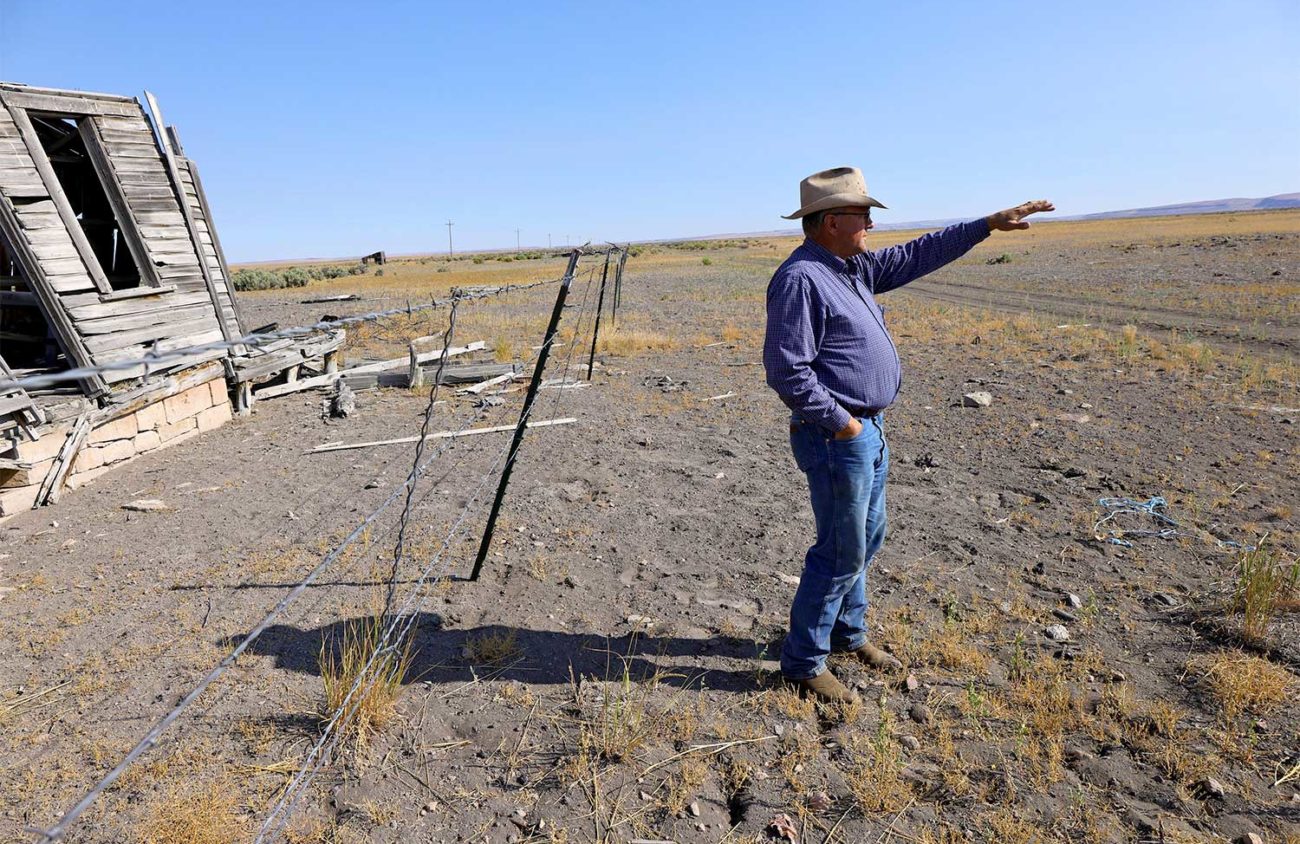A four-strand barbed-wire fence runs north to south down the middle of the desert flat in the empty Catlow Valley, splitting the town of Blitzen in two.
Or at least what used to be Blitzen, before the homesteaders who came to try their hand at dry farming wheat slowly trickled out, more than 70 years ago. Now all that remains of the once-thriving community are dark wood skeletons of the former buildings, their structures skewed to one side or the other after half a century of weathering the elements. Eventually, two ranchers both wanted to buy the property of Blitzen, and they ended up dividing it down the middle.
One of those ranchers is Stacy Davies, manager of Roaring Springs Ranch, who wears a button-up collared shirt and a dirty cowboy hat to provide shade from the morning heat as he points to the dilapidated buildings. He tells me there used to be a post office, a store, a church, a saloon. Beyond the ghost town, the sagebrush and short yellowed grass continues for miles, the former town only a blip in the desert.
Land east of the endless barbed wire now belongs to Roaring Springs Ranch, one of the largest cattle operations in Oregon. The west side belongs to Rock Creek Ranch, another large cattle operation and friendly competitor. The two ranches share a 40-mile boundary that divides the ghost town of Blitzen, but they operate on very different philosophies.
I drove out to this remote area of southeast Oregon with a Eugene Weekly colleague who took photos, to learn about life on these ranches in this rugged country, where the nearest neighbors are cattle and deer, and a big grocery haul entails a seven-hour round trip to the Costco in Bend. These isolated mountains and desert flats feel like another planet compared to the west side of the state, granting a solitude that isn’t lonely.
“This is the smallest population that has ever lived in this valley, now,” Davies says. Blitzen faded away after the main road was moved away from the valley, he explains, and bigger companies bought up the land to create larger ranches, eventually ending the homesteading way of life.
Although Harney County is one of the biggest in Oregon, it has a population of only about 7,000. Most of the homesteaders eventually left, but the legacy of the American cowboy is still alive. Taking care of cattle and making a living through the harsh high-desert seasons is no easy feat, but for those who fantasize about riding horses into the mountains and sleeping under the stars away from civilization, this way of life is a dream come true.
“Living here and working here is really a labor of love. People do it because they love it,” Davies says, adding later, “But it’s far more complicated than people think.”
Enlarge
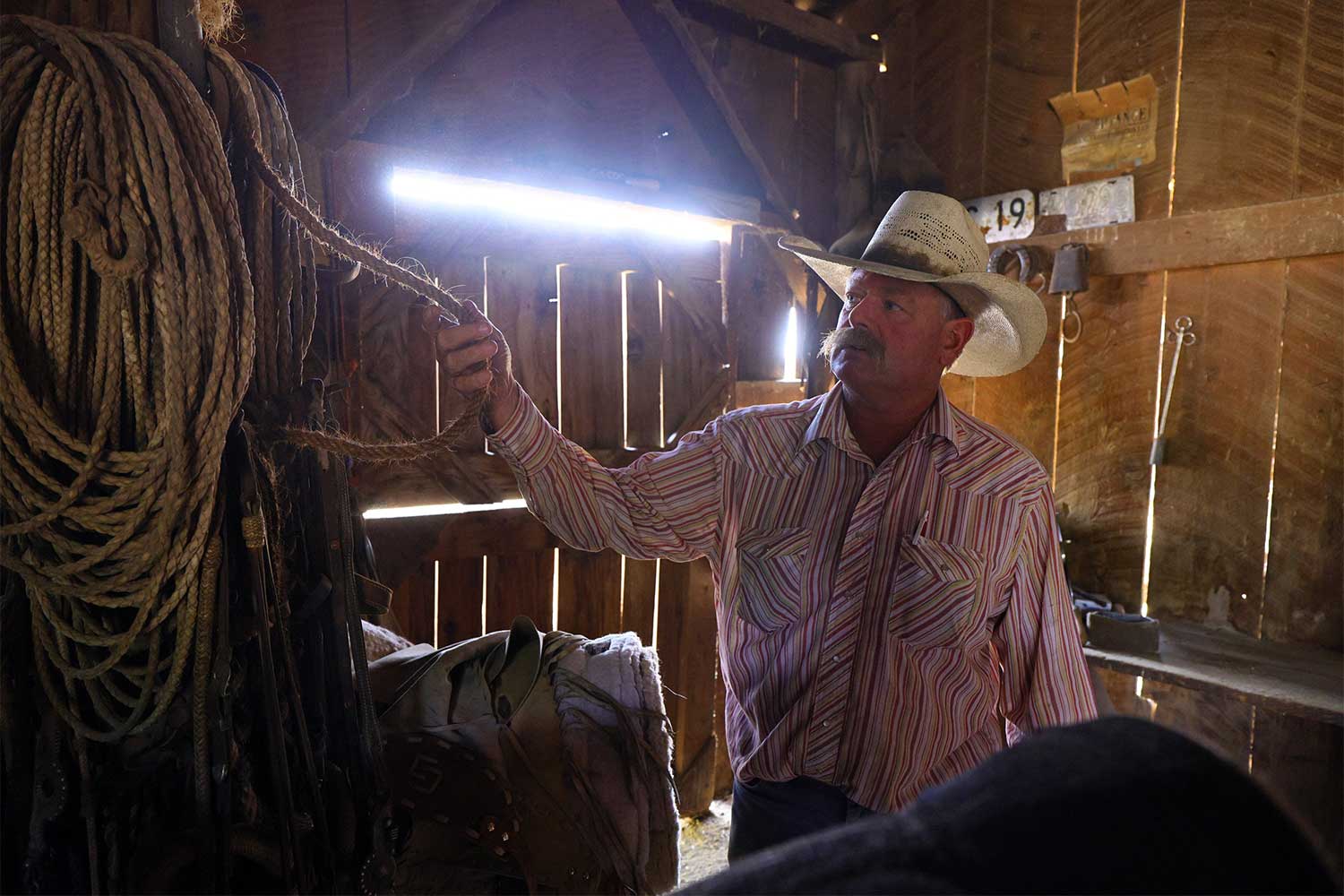
Ranching in the Blood
Davies knew from a young age he wanted to become a ranch manager. He grew up on a ranch in Utah, his family a part of the Church of Jesus Christ of Latter-day Saints. When Davies was young, he was really good at school, he says, but was often bored. He started to act up in class. This concerned Davies’ grandfather, with whom he was really close, so his grandfather sat him down and told Davies he needed to choose a career. He was too smart to waste his life.
“He could see that it would lead to more trouble if it wasn’t curbed,” Davies says. Not even a week after, the young man saw an ad on the back of a beef magazine for a ranch management program at what was then Ricks College, now Brigham Young University – Idaho, in Rexburg, Idaho. He tore out the magazine ad and pinned it to his wall with a thumbtack. “Then I said, ‘I want to manage a ranch,’” he says.
Davies met his wife, Elaine Davies, in college in Idaho. Now both in their fifties, they have six grown sons. Elaine Davies is friendly and engaging, with bits of gray shining through her wavy red hair. She says she loves life on the ranch.
“I like the feeling of being away from people,” she says. “It doesn’t bug me that bad.” She adds that it’s the best place in the world to raise kids because they’ve grown up having to solve problems most kids never encounter.
Roaring Springs was originally a part of the historic P Ranch, put together by cattleman Pete French in the late 19th century. Today, Roaring Springs operates on about 1.2 million acres, Davies says, roughly the size of Clackamas County. This includes 254,000 acres owned, and 980,000 acres of land used for grazing under permits from the Bureau of Land Management (BLM) and others.
In 1992 the ranch was purchased by the Sanders family, University of Oregon alumni who were owners and operators of a timber company in Washington. Before he died, Bob Sanders donated $17 million to UO to build the Jane Sanders Softball Stadium in 2016, in memory of his late wife. The ranch is still owned by members of the Sanders family today.
In 1997, Davies signed on to manage it, building it up to what it is today with goals of environmentalism and sustainability.
When the Davies arrived at Roaring Springs, a mover brought their belongings from a ranch where they worked in Florida. But the mover refused to unload their things, telling them they wouldn’t last out there.
“He said, ‘You guys aren’t going to stay here. No one wants to live this far out, so I’m not going to even unload it,’” Davies says. The driver said he would not come back and pick up their things after the Davies gave up.
But the family was ready for the change. They knew the West and what they were getting into. It was a blank canvas of unspoiled beautiful landscape, he says, and a wonderful economic opportunity.
“When Elaine’s mother came to visit, she said that you drive and drive until you think you are going off the end of the Earth. Then you turn the corner, and there you are,” Davies says.
Davies says his strategy is to be the third manager of a ranch after it is purchased. The first hired manager is often a family member, lasting about a year. The second person lasts maybe three years because the owners still try to micromanage. By the time a ranch owner gets to hiring the third manager, they realize they need to let the expert do the work.
“I was in the right place, at the right time, with just the right preparation,” Davies says of becoming the Sanders’ third manager at Roaring Springs.
Ranching by tradition
Miles away, on the other side of Blitzen, Rock Creek Ranch has a more modest headquarters, where a friendly great Pyrenees dog comes to greet visitors, and the buildings are simple. Far from having a corporate owner who hires a manager, the ranch is owned and run by fourth generation rancher Gary Miller. We visit him at the Rock Creek headquarters, driving 20 minutes down a gravel road off of the main highway until we spy several trees and buildings, the only ones to be seen for miles across the sagebrush and sand. Here, Miller tells me, there are no natural springs, so they get their water from a reservoir his grandfather built on Rock Creek when the land was purchased.
Miller points out remnants from his family’s cowboy past scattered along the property — old rusty vehicles and wagons, hand-forged branding irons, skulls of animals long gone. He grew up in this part of the state, his family woven into the history of early homesteaders.
Rock Creek Ranch was started in 1938 by Miller’s grandfather, who bought it for $11,000. It was passed on to Miller’s father and, eventually, to Miller in the 1990s. He married his wife, Michelle Miller, and worked the ranch while she raised their three sons, now fully grown with kids of their own.
The ranch operates on about 350,000 acres, Miller says, 50,000 owned and the rest permitted grazing. An affable man with a thick reddish-gray mustache, Miller sits at his kitchen table in his ranch attire, spinning stories of his family through the generations. He jumps from simple facts to complicated tragedies together in the same sentence using the same casual voice one would use to explain what they ate for dinner the other night.
Miller’s great-grandfather owned a ranch in the nearby Double-O valley, he says.
“In 1901, he went to prison for killing Curtis and then lost the ranch. But that’s another story,” Miller says, taking a breath before continuing, “Anyway, we ended up back in the valley there. And in 1972, well that’s when things changed because Joe and Jerry were having trouble.”
“Which two are Joe and Jerry?” I ask.
“Oh those are Grandpa’s younger brothers,” Miller says.
The inside of Miller’s home is tidy, photos of his family hanging on the wall above a large table where the ranch cowboys and the Miller family eat their meals. Miller apologizes for any lingering odors because he and his wife were just dealing with some recently butchered beef. But there is no smell and the kitchen is clean, down to the dishcloths hanging neatly over the side of the sink.
The Miller family depends on the traditions of the vaqueros, the Spanish word for cowboys. Vaqueros, for example, rope cattle with a handwoven loop called a riata and train horses using a hackamore before teaching a horse to take a bit. Training horses the vaquero way is a slower process, more focused on quality over fast results.
“Then you’ve got a horse that responds in the most magnificent way,” Miller says. He adds that his son braids the riata and there is a difference in the feel of the rope and how far it is thrown.
Enlarge
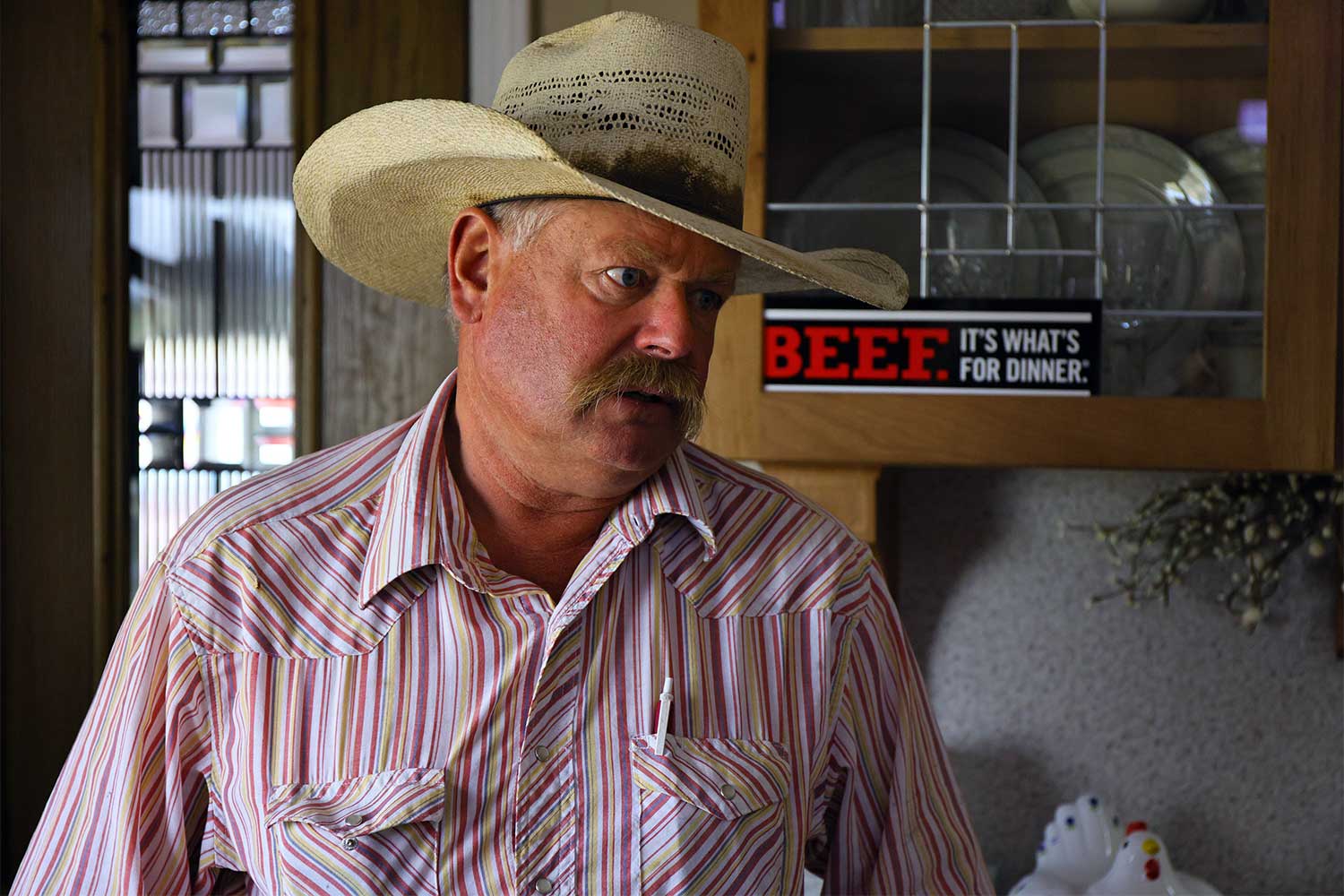
Regenerative farming
It’s still early when we meet Davies the next morning for a tour of Roaring Springs Ranch. The first destination he drives us to in his shiny Lincoln Navigator, though, is not a pasture full of cows. It looks more akin to a field of weeds. This field is full of turnips, Davies explains.
In 2007, Roaring Springs was one of seven regional winners in the annual Environmental Stewardship Award Program, which recognizes “innovative and cost effective approaches to land stewardship on their working cattle operations.” Nominated for the award by the Oregon Cattlemen’s Association, Roaring Springs was commended for its work removing threats to native fish species and improving other wildlife habitats.
Today, Davies says they continue to run the ranch to fit in with nature, not spending a lot of money on fossil fuel dollars fighting with nature to increase production.
“Anytime you fight nature there are going to be costs,” Davies says. One of their current projects is 1,700 acres of regenerative agriculture. Davies says he knew of regenerative ag for a while, but his son Eric wanted to apply it. They are now in their third year — growing corn and 27 varieties of other plants. They will harvest one crop of hay and leave the other crop, letting the cattle graze in the late winter. This reduces their use of tractors across the field from 16 times a year to about six.
“In addition, we won’t fertilize anymore, and we don’t expect that we’ll have to use any pesticides any longer,” Davies says.
Replacing herbicides and pesticides with seed costs about the same as conventional farming, Davies says, but it reduces the amount of fossil fuel used by 25 percent.
He emphasizes that this project is a small part of the ranch’s operations, but they are going to document and learn and adjust as needed. Davies says they freely share information and research with other ranches who want to know it.
“We give tours. And some of the rangelands stuff we’ve done is being copied across the West,” he says. “I think we are the only people in Harney County that have advanced regenerative ag to the point we have, and we are just getting started.”
Roaring Springs employs a full time wildlife biologist, something Davies says is not common at big ranches in Oregon. The biologist’s job is to help figure out how to best sustainably manage the wildlife and landscape including populations of up to 500 pronghorn antelope, 200 elk and 150 bighorn sheep.
Davies says his views on sustainably running the land come both from his religious background as well as his experience working for other ranchers and with agencies throughout the years.
“For me personally, it does have roots in our religion, that we are to be good stewards of the land and people and communities,” Davies says, adding that it has been a lifetime of learning these strategies and ideas from others.
At his kitchen table on the other side of Blitzen, Miller explains when it comes to ranching, he has a different holistic view of the land, one influenced by the generational knowledge passed down to him.
Rock Creek Ranch prides itself on traditional methods. They don’t use motorized vehicles to drive the cattle — they use horses, because Miller says it’s better to understand the capabilities of an animal and learn from an animal than to use an ATV.
“One of the hardest lessons to learn is how much your horse can give you,” Miller says. “You know how much an ATV can give you by the gas gauge.”
Overall, sustainability is a priority for many ranches in Harney County these days, says Marc Hudson, the rangeland program director with Oregon Agricultural Trust. Hudson works with about 25 ranches in Harney County — none of which are Roaring Springs or Rock Creek — and says that overall there are a variety of decisions ranches can make to manage the land in a way that’s environmentally friendly.
“Roaring Springs is pretty unique,” he says, because of how big it is. “They probably have a lot more opportunities and a heightened sense of sustainability.”
At Roaring Springs, we get back in the car, head south, and Davies turns east off of the Catlow Valley road up into an area called Skull Creek. He explains on the drive up that there is a bighorn sheep population that lives near the ridge. On our way back, we spot a group of at least 10 of them in a pasture by the highway.
The creek bed is dry this time of year, but we follow the narrow gravel road that snakes up a valley between the hills until we reach a small white hunting cabin and a meadow of lush green grass, quivering lightly in the breeze. We make a brief stop at the cabin, which Davies says is used on occasion by people working at the ranch or by the owners.
The cabin has one small central room and two tiny bedrooms stuffed with bunk beds. Two large buck heads hang in the back, and a walk-in pantry is filled with non-perishable food like hot sauce and cans of soup.
Davies drives us up the road towards the low lying hills until we have a view of the green valley and the bare Pueblo Mountains in the distance. We stop at a curve in the gravel road and I look to my right, across other hills and buttes, and at the cloud shaped shadows giving them depth.
“How far does Roaring Springs go?” I ask.
“As far as you can see from here,” Davies says.
Cowboy Mormon decor
One day, Davies brings us to his home at the headquarters. The modern four-bedroom house is where he and Elaine Davies raised a majority of their kids, each room filled with several beds. Animal heads crowd the living room walls. Davies says one head from every species on the ranch is on display — a deer, an elk, a bobcat and even a river otter. A taxidermied cougar that once stole livestock from the ranch prowls a ceiling beam. On the next wall hang plaques commemorating the Davies children and their completed Mormon missions.
Davies says that the other ranch staff usually gets Christmas and New Years off, leaving the Davies family to manage the ranch on the holidays. The rule was that the animals had to be fed before presents were opened. They would return mid-morning to begin the festivities.
“Living remote and living on the ranch, that’s something you do,” he says. “Take care of animals first, and people second.”
As we make our way into the kitchen, furnished with cabinets made from juniper trees cut on the ranch, Davies says he doesn’t usually eat lunch, but offers a can of Nalley beef stew. Immediately, I recall a magazine I read as a kid that described life as an American cowboy. “They sleep under the stars and eat food from a can,” it said.
Davies takes off his hat as we sit at the wooden table, revealing a balding head. As we eat the canned stew and bread, he talks about his dreams for retirement in four years. He says he and Elaine Davies bought a ranch in nearby Diamond, Oregon, in 2000 and put it into a separate LLC. Under a deferred compensation plan with Roaring Springs’ owners, the Davies gain 4 percent ownership of the ranch in Diamond each year, so that by 2026 they will own it outright. Their son will manage the ranch and eventually purchase it, the payments going towards Elaine and Stacy Davies’ retirement.
In retirement, the Davies plan to use their time and money to do mission work, he says, traveling to places people may be afraid to travel to — Africa is mentioned — and helping those in need.
Enlarge
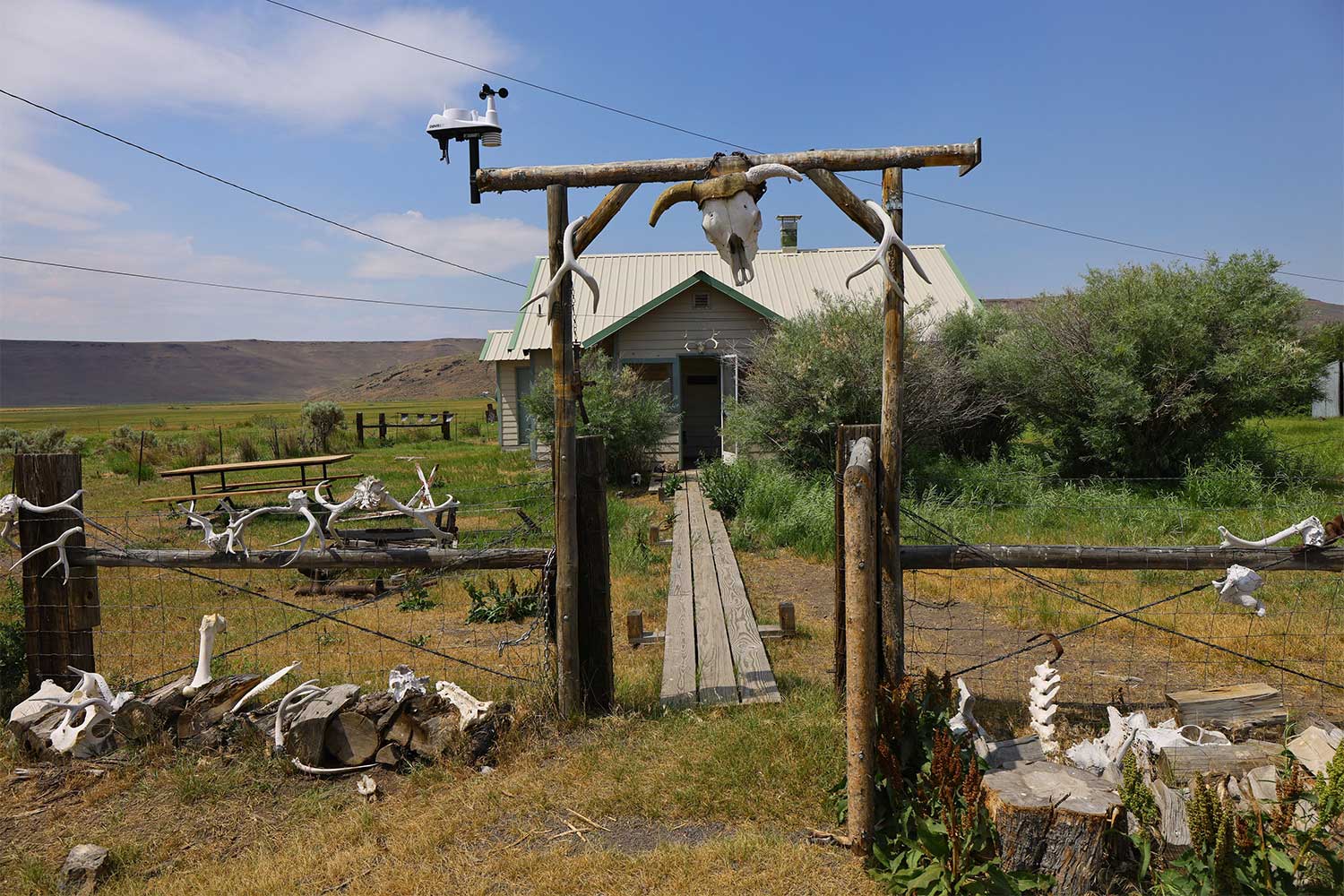
From can see to can’t see
Half a dozen young men live in the bunkhouse at the Roaring Springs Ranch headquarters this summer. They work hard, long days on the ranch to keep it running. Some are starting their careers in ranching, and others are just following a dream to be a cowboy.
Will Duffy, 23, a well-mannered ranch hand with short-cut blond hair, was born and raised in the heart of Portland. Two years ago, he decided he wanted to get out of the city. A close family friend asked if he ever heard of Frenchglen, Oregon. Duffy hadn’t.
“I just wanted a cowboy job where I could ride every day and check cows and stuff and that’s what this place offered,” he says.
The first day, he says, they moved cows from one part of the desert into another pasture. He was hooked from the start. Duffy liked it so much that he came back this summer to work for a few months again.
“I’m actually commissioned as a second lieutenant in the Marine Corps,” he says. “I just know that I’m never going to get an opportunity like this.”
He admits he had a somewhat romanticized view of what working on a cattle ranch would be like, but after a few weeks, he adjusted.
“We don’t encounter people in America like this anymore,” Duffy says. “People should understand that cowboys are still here and there is still a very strong work ethic.”
Part of Davies’ mission as a rancher is training new cowhands, he says. So when he gets calls from families and groups such as Boy Scouts, asking if kids can come learn ranch work, he often says “yes” — a rarity among ranchers. Some of the kids are troubled, and few have experience as cowboys. Davies takes them anyway.
“Parents call and say, ‘I just realized my son is 16 and I’ve never taught him to work. Can you teach him how to work?’” Davies says. He adds that they take two a year, kids with almost the same story every time. “They have a desire to work, but they don’t have any ability to think and problem solve.”
For the kids, it’s a tough adjustment. They usually call their parents every night the first few weeks, begging to be sent home.
“They think they’ve died and gone to hell,” Davies says with a laugh, adding that in those first weeks their thighs are chafed from learning to ride horses and their whole bodies are exhausted from the long days.
They learn self-reliance. There’s no cell service, and when they can’t open a wire gate, they can’t look it up on YouTube. Davies says as a manager — and as a Mormon — it’s important for him to help share knowledge with others so they can develop these skills.
“We believe in life after death, and the only thing you really take with you is your knowledge and relationships,” Davies says as the car curves around the bend of a hill. “You don’t take land, you don’t take money and you don’t take worldly things. But you do take your knowledge.”
Both Miller and Davies raised their children on ranches. During the school day, their wives or friends drove the kids into Frenchglen, which still has a one-room schoolhouse. Since the school doesn’t have bus service, parents get paid mileage, at the IRS rate of more than 50 cents per mile, to drive to school. The trip from Roaring Springs is 15 miles, one way.
For high school, many kids attend a public boarding school in Crane, 75 miles north of the Roaring Springs Ranch headquarters. Students live there Monday through Friday, spending weekends at home.
“Sometimes we had to drive up to Joseph or North Powder and back for away basketball games,” Davies says. The drive takes about six hours when there is no snow on the road.
Getting medical help can also be difficult. Miller says his pregnant daughter-in-law scheduled her delivery date so she could drive over to Bend to have the baby.
At Roaring Springs, roughly 75 miles from the nearest hospital in Burns, Elaine Davies got her certification as a first responder in the case of accidents at Roaring Springs or on the state highway that cuts through it. If anyone gets injured, Davies can help assess what needs to happen and communicate with an ambulance or a life flight plane if needed.
Country roads, take me home
On the first Saturday of each August, ranchers and other families of the Blitzen and Catlow valleys celebrate their community at the Frenchglen Jamboree, a tradition that has carried on for over 50 years. The families spend their mornings at the corral on the north end of the tiny town of Frenchglen, named for P Ranch owner Pete French and his business partner Hugh Glenn, where tiny 4- and 5-year-olds in cowboy hats — both boys and girls — ride tall horses while their parents lead them around a dusty barrel race pattern, and older kids compete in calf-roping. This year, the jamboree was planned by Miller’s daughter-in-law.
In the evening, we return for the jamboree barbeque, and it’s like stepping through time. The ranchers sit at picnic tables and on hay bales in the lawn next to the old Frenchglen Hotel. They wear variations of the same clothing, trading out their dirty ranch cowboy hats for clean ones, plaid button-up shirts, jeans and boots. Not a single pair of skinny jeans in sight. We join them to eat smoked beef, corn on the cob and watermelon off of paper plates while families play horseshoe on the hillside. Across the street is the one-room schoolhouse where most of their kids went to elementary school.
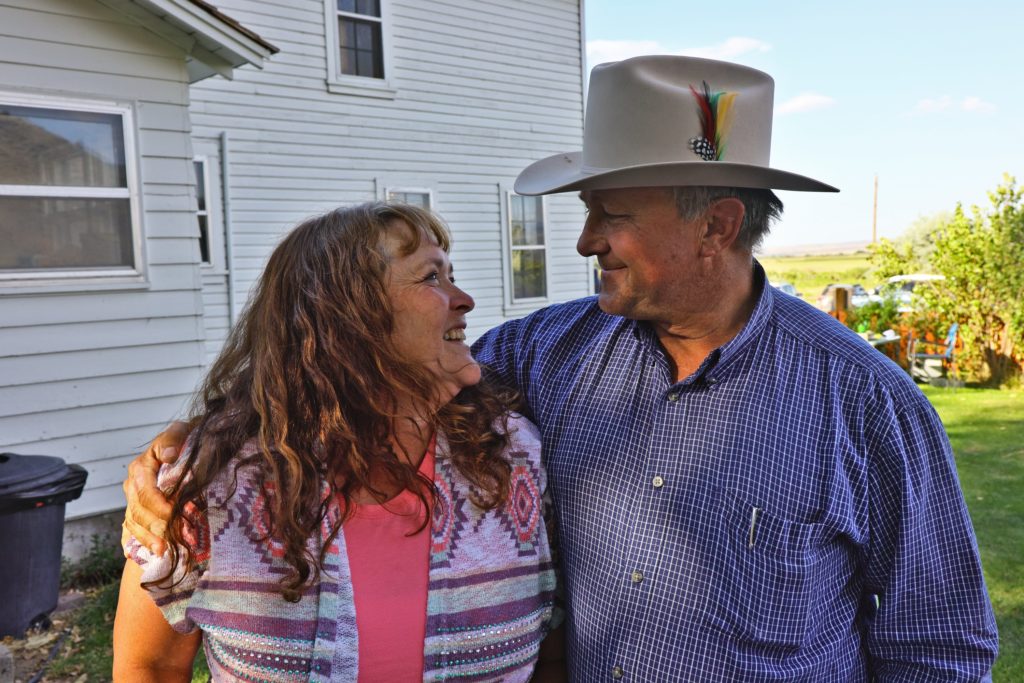
Davies and Miller shake hands and greet each other warmly at the jamboree. If there are grudges or suspicions held between ranchers and their families, they are left at the threshold of the lawn where the evening sun casts a golden light on the distant Steens Mountain. A cover band plays “Mama Don’t Let Your Babies Grow Up to be Cowboys,” as I go to speak with a handful of young men working at Roaring Springs, who, in fact, did grow up to be cowboys.
Later, the sun sets in the Catlow Valley. Shadows grow long on the ridge behind the Roaring Springs Ranch headquarters while cattle graze across the state highway, awaiting nightfall. Some ranchers remain at the jamboree, drinking beer and watching their kids play on the hay bales.
After the 15-mile drive back to the ranch, the workday isn’t yet over for Stacy and Elaine Davies. A herd of cattle has been grazing all day around headquarters. Stacy mounts a red and black dirt bike with Elaine on a quad just ahead of him. They have to drive the cattle into a pasture for the night so they don’t become a hazard for passing cars on the state highway.
The rancher looks across the desert, then down on his motorbike. “If only this was a horse,” he laughs. With a courteous wave, he rides off into the sunset. ν
